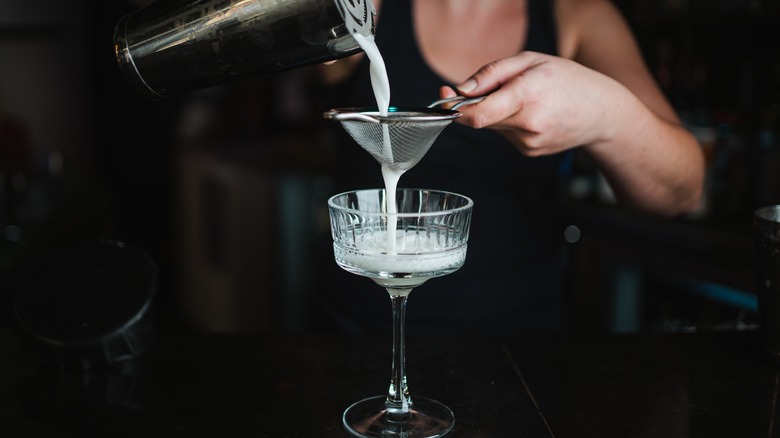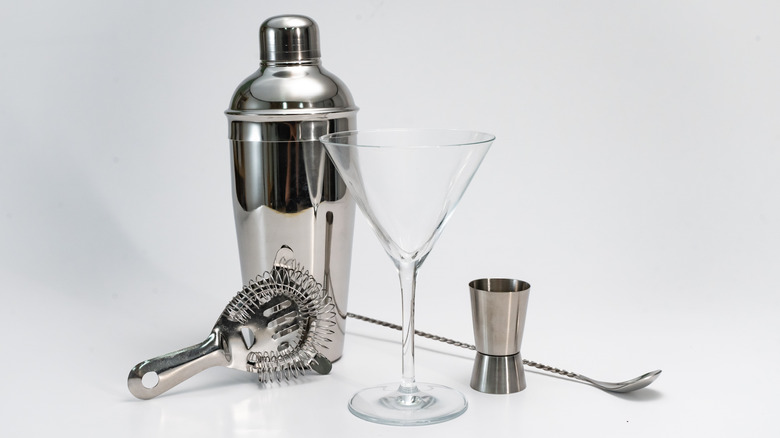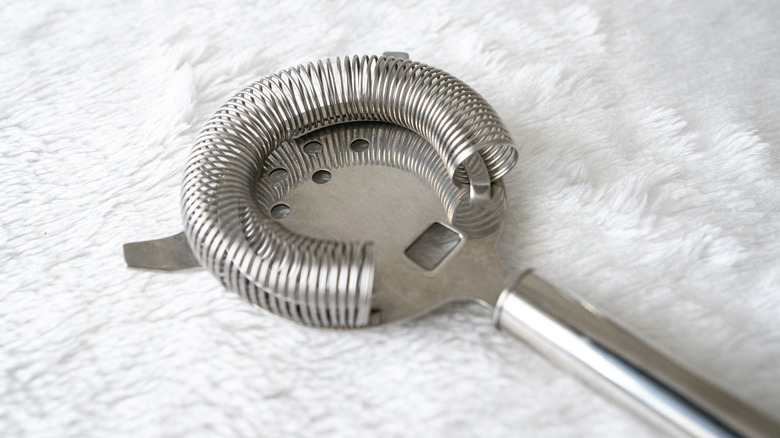The Straining Tip To Keep In Mind For Crafting The Best Cocktails
The eternal question of stirred versus shaken cocktails has plagued pop culture since James Bond first uttered the words on screen in 1964. But no matter how you prefer your martini, there is one piece of equipment you can't go without. While many libations at a bar differ greatly in how they're prepared from one another, essentially no drink is made without a strainer. And in some cases, even two.
Bartenders employ the use of two tools that have varying purposes but are equally as important. When thinking of a strainer, most people imagine the cobbler or Boston cocktail shaker bartenders use as their primary weapon of choice. But they may not realize how properly straining your drink is the best method for crafting cocktails. The reason for this is because of the tricky ice in all drinks. Using a cocktail shaker with ice cools the drink, but it is also a vicious process. The movement of shaking cocktails often breaks up the ice in the process — a problem for iceless drinks like Cosmos. This result is why many use a second tool, otherwise known as a Hawthorne strainer. Also called a fine strainer, the Hawthorne stops any additional solids from passing into the drink. It adds a level of professionalism when mixing cocktails at the bar or in the privacy of your own home.
The Hawthorne strainer
The cocktail shaker is instrumental to any refreshing drink. Even if there is no ice in the drink, shaking the liquid in a tower of ice cools the drink so it becomes even more palatable. But for iceless drinks like your hot and dirty martini, any ice stragglers landing in your drink ruin the effect. Ice dilutes the strength of the drink, not to mention it affects the taste. Thus, the Hawthorne strainer was born. This tool removes any likelihood of wayward ice cubes and gives the best consistency for drinkers.
Introduced in the late 1800s, the Hawthorne was a response to the Julep strainer. So named for the iconic drinks that it makes, the strainer was essentially just a spoon with holes in it. You could make Mint Juleps with it, but some ice was likely to escape. To combat this, an attachment was made with a plated coil to stop ice from getting through. While strainer technology has advanced in the centuries since then, the Hawthorne remains a welcome tool for the most elegant pour.
How to use a Hawthorne strainer
In the world of bartending, ice crystals can mean death to the flavor of a cocktail. Ruining the taste and visual aesthetic of the drink, ice — among other ingredients — should stay in the shaker where it belongs. Because of the process of shaking, the ice inside has already started to dilute and break down. Bartenders usually use fresh cubes for the final product so as not to dilute the drink further.
But there are those drinks that not only require cobbler strainers and Hawthorne strainers. Some cocktails, like Daquiris, should be double strained because of additional ingredients present. Bartenders will add fruit or herbs to a drink that the Hawthorne strainer will not catch. This requires the use of an additional strainer called the fine strainer. Similar to a tea strainer, this tool stops miniscule ingredients from polluting the drink. You can use a sieve to make sure drink remnants do not escape. Double straining provides a clearer drink with a better balance. To ensure the drink stays cold without ice, use a glass with a high stem. Holding the glass by the stem will ensure that the heat from your hand doesn't resort the drink to room temperature. Make sure to properly strain your cocktails and you will step up your cocktail prowess.


